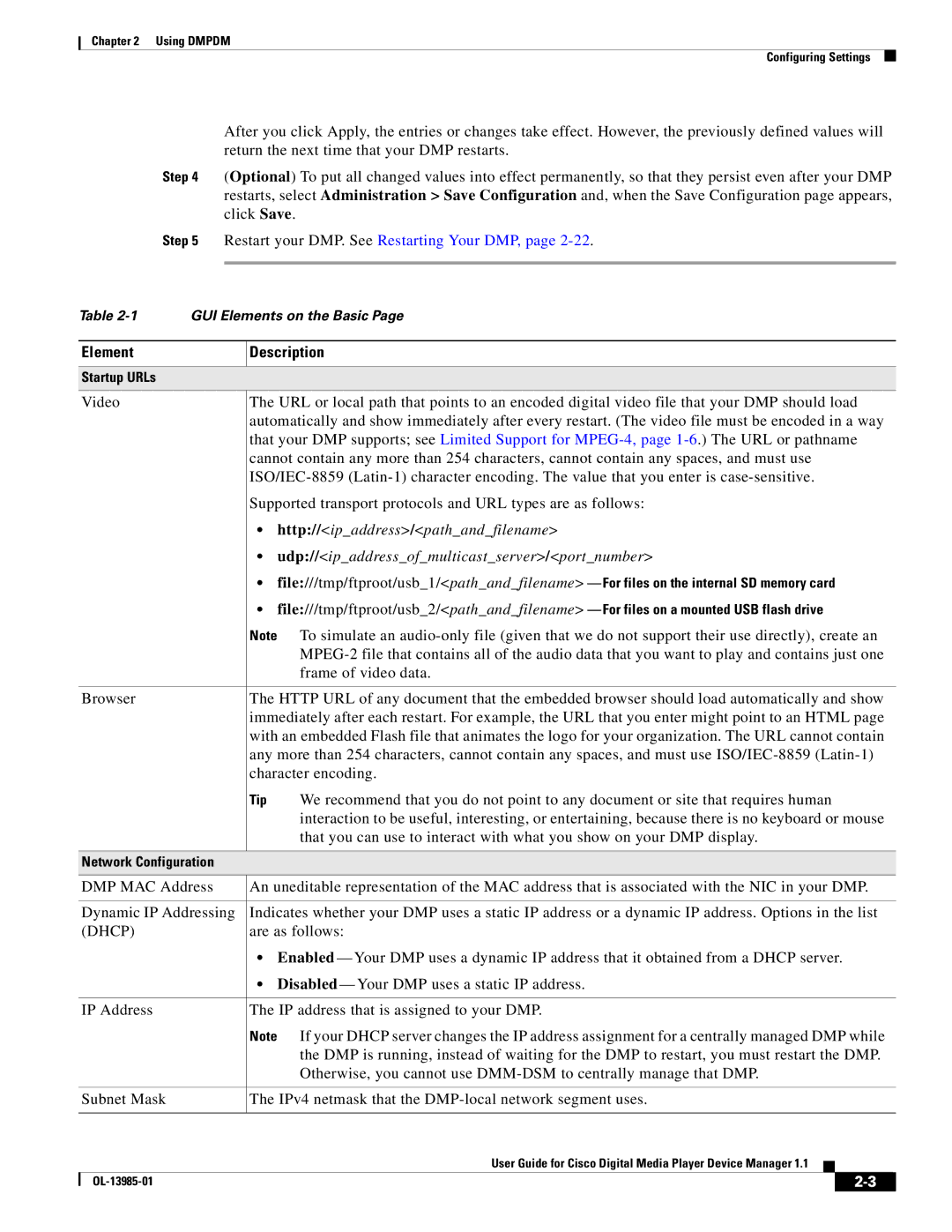
Chapter 2 Using DMPDM
Configuring Settings
After you click Apply, the entries or changes take effect. However, the previously defined values will return the next time that your DMP restarts.
Step 4 (Optional) To put all changed values into effect permanently, so that they persist even after your DMP restarts, select Administration > Save Configuration and, when the Save Configuration page appears, click Save.
Step 5 Restart your DMP. See Restarting Your DMP, page
Table | GUI Elements on the Basic Page |
Element
Description
Startup URLs
| Video | The URL or local path that points to an encoded digital video file that your DMP should load | ||||
|
| automatically and show immediately after every restart. (The video file must be encoded in a way | ||||
|
| that your DMP supports; see Limited Support for | ||||
|
| cannot contain any more than 254 characters, cannot contain any spaces, and must use | ||||
|
| |||||
|
| Supported transport protocols and URL types are as follows: | ||||
|
| • | http://<ip_address>/<path_and_filename> | |||
|
| • | udp://<ip_address_of_multicast_server>/<port_number> | |||
|
| • file:///tmp/ftproot/usb_1/<path_and_filename> — For files on the internal SD memory card | ||||
|
| • file:///tmp/ftproot/usb_2/<path_and_filename> — For files on a mounted USB flash drive | ||||
|
| Note To simulate an | ||||
|
|
| ||||
|
|
| frame of video data. | |||
|
|
| ||||
| Browser | The HTTP URL of any document that the embedded browser should load automatically and show | ||||
|
| immediately after each restart. For example, the URL that you enter might point to an HTML page | ||||
|
| with an embedded Flash file that animates the logo for your organization. The URL cannot contain | ||||
|
| any more than 254 characters, cannot contain any spaces, and must use | ||||
|
| character encoding. | ||||
|
| Tip | We recommend that you do not point to any document or site that requires human | |||
|
|
| interaction to be useful, interesting, or entertaining, because there is no keyboard or mouse | |||
|
|
| that you can use to interact with what you show on your DMP display. | |||
|
|
|
|
|
|
|
| Network Configuration |
|
|
|
|
|
|
|
| ||||
| DMP MAC Address | An uneditable representation of the MAC address that is associated with the NIC in your DMP. | ||||
|
|
| ||||
| Dynamic IP Addressing | Indicates whether your DMP uses a static IP address or a dynamic IP address. Options in the list | ||||
| (DHCP) | are as follows: | ||||
|
| • | Enabled — Your DMP uses a dynamic IP address that it obtained from a DHCP server. | |||
|
| • Disabled — Your DMP uses a static IP address. | ||||
|
|
| ||||
| IP Address | The IP address that is assigned to your DMP. | ||||
|
| Note If your DHCP server changes the IP address assignment for a centrally managed DMP while | ||||
|
|
| the DMP is running, instead of waiting for the DMP to restart, you must restart the DMP. | |||
|
|
| Otherwise, you cannot use | |||
|
|
| ||||
| Subnet Mask | The IPv4 netmask that the | ||||
|
|
|
|
|
| |
|
|
| User Guide for Cisco Digital Media Player Device Manager 1.1 |
|
| |
|
|
|
| |||
|
|
|
|
|
|
|
|
|
|
|
| ||
|
|
|
|
| ||
